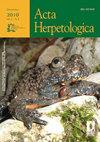Diet and trophic niche overlap of four syntopic species of Physalaemus (Anura: Leptodactylidae) in southern Brazil
IF 0.9
4区 生物学
Q4 ZOOLOGY
引用次数: 0
Abstract
Despite the current increase in studies on the diet of neotropical anurans, few of them take a comparative approach between syntopic species. The objective of this study was to compare the diet of four syntopic species of the genus Physalaemus. The collections occurred between November 2014 and January 2016 in a preserved area of the subtropical Atlantic Forest in southern Brazil. We compared the gastrointestinal content of 109 individuals distributed in the species Physalaemus biligonigerus, P. cuvieri, P. gracilis and P. henselii. We measured the Index of Relative Importance of each prey category and calculated trophic niche breadth using the Levins’ index (Bsta) and trophic niche overlap using the Pianka’s index (Ojk). We also applied compositional analysis to evaluate feeding specializations. Formicidae was the most important prey category for P. biligonigerus (IRI = 88.5%) and P. gracilis (IRI = 39.1%). For P. henselii and P. cuvieri, the most important category was Isopoda (IRI = 51.7% and 57.9%, respectively), followed by Formicidae (IRI = 34.9% and 24.8%). Isopoda was also important in the diet of P. gracilis (IIR = 28.6%), followed by Araneae (IIR = 22.6%). The trophic niche breadth of the four species was narrow, all smaller than 0.32, and the lowest was recorded for P. biligonigerus (0.04). The trophic niche overlap was higher between P. biligonigerus and P. cuvieri (96%), and between P. gracilis and P. henselii (95%). Only P. gracilis presented a significant level of feeding specialization. The differences in their diets suggest different uses of the resources, which could relate to different ways of exploring the microhabitat.巴西南部四种同生Physalaemus(无尾目:细足目)的饮食和营养生态位重叠
尽管目前对新热带无尾类动物饮食的研究有所增加,但它们中很少有对同生物种进行比较。本研究的目的是比较四种Physalaemus属同期物种的饮食。这些采集发生在2014年11月至2016年1月,地点是巴西南部亚热带大西洋森林的一个保护区。我们比较了109个分布在Physalaemus biligonigerus、P.cuvieri、P.gracilis和P.henselii物种中的个体的胃肠道含量。我们测量了每个猎物类别的相对重要性指数,并使用Levins指数(Bsta)和Pianka指数(Ojk)计算了营养生态位宽度和营养生态位重叠。我们还应用成分分析来评估喂养专业化。Formicidae是P.biligonigerus(IRI=88.5%)和P.gracilis(IRI=39.1%)最重要的猎物类别。对于P.henselii和P.cuvieri,最重要的类别是异足目(IRI=51.7%和57.9%),其次是Formicidae(IRI=34.9%和24.8%)。异足目在P.gracillis的饮食中也很重要(IIR=28.6%),其次是Araneae(IIR=22.6%)。四个物种的营养生态位宽度都很窄,均小于0.32,其中P.biligonigerus的营养生态位宽最低(0.04)。P.biligoningerus和P.cuvieri之间的营养生态位数重叠度较高(96%),P.gracilis和P.henselii之间的营养微位重叠度较高(95%)。只有纤薄P.gracilis表现出显著的饲养专业化水平。它们饮食的差异表明了对资源的不同使用,这可能与探索微栖息地的不同方式有关。
本文章由计算机程序翻译,如有差异,请以英文原文为准。
求助全文
约1分钟内获得全文
求助全文
来源期刊

Acta Herpetologica
ZOOLOGY-
CiteScore
1.20
自引率
12.50%
发文量
10
审稿时长
6 months
期刊介绍:
Acta Herpetologica, a journal open to academics all over the world, offers itself as a new site for the presentation and discussion of the most recent results in the field of research on Amphibians and Reptiles, both living and extinct. The official journal of the Societas Herpetologica Italica (S.H.I.), Acta Herpetologica publishes original works – extended articles, short notes and book reviews – mostly in English, dealing with the biology and diversity of Amphibians and Reptiles.
 求助内容:
求助内容: 应助结果提醒方式:
应助结果提醒方式:


